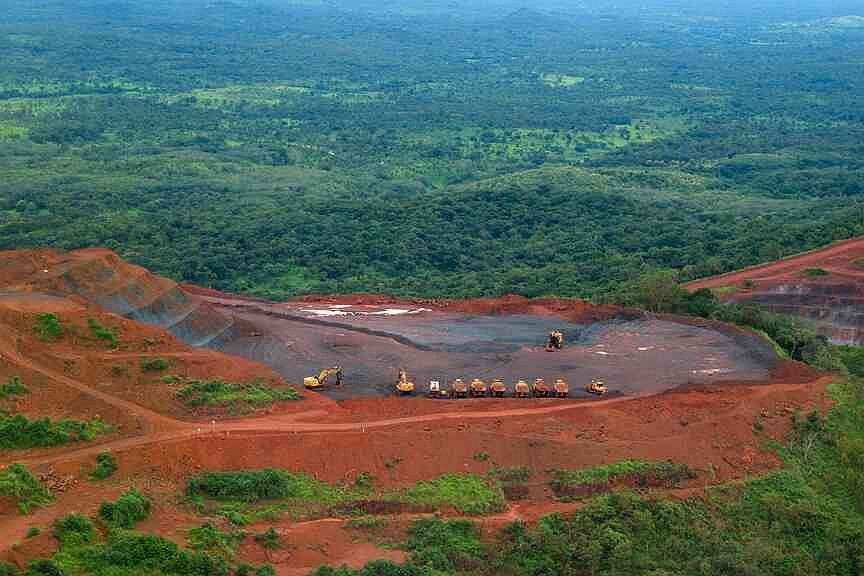Copyright Arkansas Online

In April 1998, a young geologist and his team set out from the village of Moribadou and trekked for six hours through the Guinea Highlands, a densely forested plateau that spreads across four countries in West Africa. "It was extremely difficult," said Sidiki Koné. "In front was forest. It was forest to the left and forest to the right. Behind it was the same thing. And I said 'how is this work possible?'" Koné was mapping and drilling for his employer Rio Tinto Group, one of the largest mining companies. It had recently confirmed the presence of vast quantities of iron ore -- the raw material for manufacturing steel. The Simandou deposit, buried below one of the world's most biologically rich ecosystems, was first explored in the 1950s when Guinea was still a French colony. It would turn out to be one of the biggest on the planet. The remoteness of the iron-rich mountains that daunted Koné -- combined with military coups, corruption scandals and corporate intrigue -- helped keep Simandou's valuable trove in the ground for almost three decades. Yet, a brand-new railway last month began carrying ore to a purpose-built port, from where it will be dispatched to China's steelmaking furnaces some time before the end of this year. The scale of Simandou is staggering. It's the world's largest untapped iron ore deposit, with estimated reserves of at least 3 billion tons. Rio's plan involves blasting ore -- with an iron content among the highest on Earth -- from a 5-mile long sliver of mountain ridge, before moving to a second site once the first is depleted. At $23 billion, it's Africa's biggest ever mining project and could make Guinea the continent's No. 2 exporter of minerals and metals by value. And it's a moment that has the iron ore market holding its collective breath. The size and richness of the deposit means the startup at Simandou threatens to further tilt the power dynamics in a market already facing an uncertain demand future, and at a time when the top buyer, China, is pushing for greater influence over the world's most-traded commodity after oil. For years, global iron ore production has been dominated by a small handful of companies: Rio itself, alongside larger rival BHP Group and Brazil's Vale SA. Despite once holding the rights to the whole of the greater Simandou deposit, Rio now has just a quarter share and is the West's only representation. Today, Chinese firms own most of the project. Even Rio's biggest shareholder is its Chinese joint-venture partner at Simandou, Aluminum Corp. of China. The flood of rich new supplies will give Beijing more leverage to control iron ore prices and curb its dependence on foreign mining behemoths. It will help to turn a weak link in Beijing's supply chain into strategic strength, building on China's dominance in mining and refining African resources from copper to cobalt and lithium. Even before the first shipment leaves West Africa, market sentiment toward iron ore -- the mining industry's biggest earner -- has turned bearish. "Never before has China held this level of pricing power over the seaborne iron ore trade," said Tom Price, head of commodities strategy at Panmure Liberum. "Expect it to start calling the shots here." When Bloomberg visited the mine belonging to Rio's joint-venture toward the end of the rainy season in September, the site resembled an out-of-season ski run, as contractors carved out the route for a 4.1 mile conveyor belt that will transport ore down from the top of the mountain. Drawing on projects from President Xi Jinping's flagship Belt and Road Initiative, everything from workers' accommodation to ship loaders and rail sleepers have been installed at a breakneck pace using designs that have been fabricated dozens of times elsewhere. "China has built this repertoire you don't get in the West," said Aitchison, who since 2022 has headed Simfer, the consortium between Rio and Chinalco that's developing one half of the Simandou deposit. "It's where we see the benefits." A PIPE DREAM Rio has changed its chief executive officer seven times since Koné began his field studies. For the first decade after his trek through the forest, Simandou's transformation remained a pipe dream -- exploration continued on the deposits laid down almost 3 billion years ago, but it stayed an obscure outpost in Rio's portfolio. That changed in 2007, when BHP made a $78 billion hostile bid for Rio. With its back against the wall, the smaller company put Simandou at the heart of its takeover defense, trumpeting its riches as evidence that BHP's offer undervalued the company. Rio likened Simandou's potential to the Pilbara, the region of Western Australia that's home to the world's biggest iron ore mines. In the end, the global financial crisis came to the miner's rescue, but its asset in West Africa was firmly on the map. Guinea wanted to know why Rio was sitting on such a game-changing resource. The Simandou deposit has an iron content that averages above 65%, making it one of the highest and most prized grades in the world. As pressure mounted on the miner, the country's president Lansana Conté stripped the firm of half the project in late-2008, before transferring it to diamond billionaire Beny Steinmetz. Weeks later, Conté passed away. Steinmetz's BSGR quickly sold 50% of its Guinean assets to Vale for $2.5 billion. The rapid-fire chain of events would leave Simandou stuck in limbo for another decade. Guinea was run by a military junta until 2010, when Alpha Condé was elected president with promises to revamp and clean up of the mining industry. Acting on advice from billionaire hedge fund manager George Soros and former U.K. Prime Minister Tony Blair, the government produced a lurid dossier of supposed corruption that led Condé to revoke BSGR and Vale's rights to Simandou in 2014. Seven years later, a Swiss court convicted Steinmetz of bribing public officials in Guinea, and he's subsequently lost appeals. Vale has said it was a victim of a fraud perpetrated by BSGR. And Rio's involvement was also hanging by a thread. Incoming Chief Executive Officer Jean-Sébastien Jacques inherited a mess in mid-2016: the company fired two executives over a $10.5 million payment to a French consultant on the project and reported itself to regulators. Rio even tried to sell its interest in Simandou to its partner, Chinalco, but failed to close the deal. The turning point for the project came in late 2019, when a consortium of Chinese and Singaporean companies was awarded the rights to develop the two blocks previously held by the BSGR-Vale joint-venture. Winning Consortium Simandou already had a history in Guinea: one of its sister companies had built bauxite mines and was constructing a railway to a port, forming a key link in a production boom that saw the country become the world's top supplier of the ore used to make alumina, the primary feedstock for aluminum. At Simandou, the distance and terrain separating the ore body from the coast had long been the principle obstacle -- and WCS wasn't wasting any time. The consortium almost immediately began moving forward with plans for a rail corridor to get the iron ore 372.8 miles across the thickly forested countryside, and a new port complex capable of handling 120 million tons a year. At this point, Rio Tinto -- the world's second-largest mining company and the project's original owner -- looked like it might be relegated to the position of a bystander. Still, the Guinean government was adamant it wanted to keep the Western investor in its key national asset, and was encouraged in its efforts by lobbying from the U.S. embassy, according to a person familiar with the matter who asked not to be identified discussing a private issue. For Rio, momentum shifted when Bold Baatar -- the Mongolian former banker put in charge of Simandou -- saw the infrastructure already built in Guinea by Sun Xiushun, the China-born Singaporean entrepreneur who runs WCS. "The moment it became clear that was the way to go was the trip I took with Sun to see his railway network in bauxite in the north," Baatar recalled. "I saw the Chinese engineering competencies of how they can get it done." In July 2022, WCS and Rio formed a partnership to finance and build the infrastructure together. Under Condé's successor General Mamadi Doumbouya, Guinea got a 15% "free-carry" stake in the new umbrella entity, as it has in both mines. The deal needed WCS and Rio to overcome their reservations about working with each other, according to Djiba Diakite, minister director of the cabinet of the presidency. "It's companies that don't have the same business models, that don't have the same corporate culture," Diakite said in an interview. The final hurdle had been cleared. The first cargo is scheduled to start loading this month and sail from Guinea around the end of the year, when a Newcastlemax bulker will depart with about 200,000 tons of ore mined by both consortiums. Rio, which will take another year to complete its mine and port, plans to ramp up output to 60 million tons a year over 30 months, while WCS hasn't disclosed its timeline to reach the same level. The combined volume is equivalent to about 5% of global production in 2024. Information for this article was contributed by Ougna Camara, Katharine Gemmell and Winnie Zhu of Bloomberg (WPNS).



